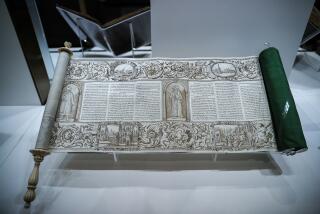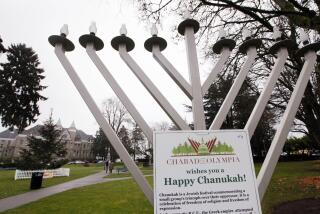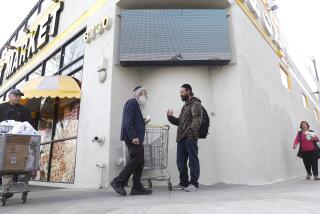Yiddish Resilience
- Share via
Yiddish was a language that almost died. Hitler and his minions did their evil best to kill it by murdering millions of Yiddish speakers in Eastern Europe.
But, almost miraculously, mame-loshen, or the mother tongue, as Yiddish is often called, has survived. More than survived, really. We are in the midst of a Yiddish Renaissance, as evidenced by the ambitious citywide Yiddish festival that wraps up this weekend.
As the late Leo Rosten pointed out in his indispensable “The Joys of Yiddish,” for centuries, Yiddish was literally the language of Jewish mothers. In the villages of Eastern Europe, Jewish men and boys learned to read Hebrew so they could devote themselves to study of the holy books. Women were not taught to read. Thus, Yiddish, a thousand-year-old variant of German written in the letters of the Hebrew alphabet, was the language of hearth, home and Mama.
Rosten quotes Nobelist and Yiddish writer Isaac Bashevis Singer’s wonderful observation that it is the only language on earth never spoken by men in power.
A language of infinite nuance, Yiddish is also uniquely suited to bleak humor. Rosten, who uses jokes to illustrate his Yiddish dictionary, describes chutzpah as the quality of the child who kills his parents then pleads for mercy because he is an orphan. You just don’t find words like that in Hawaiian.
The Skirball Cultural Center is one of more than 20 local venues participating in the Southland’s second annual festival of Yiddishkayt, or Yiddish culture.
Officially called YK2! A Festival for Yiddishkayt’s Second Millennium, the event has been an extended celebration of all things Yiddish--above all, its unlikely survival. (Perhaps the most remarkable example of the Yiddish revival is that it is now taught in many schools in Israel, where it was once disdained as the language of Jewish victimization.)
The Los Angeles festival is the most extensive Yiddish blowout in the country, despite the fact that many of the estimated 520,000 Jewish Angelenos experienced Yiddish only as the language their parents used when they didn’t want them to know what they were saying.
The Skirball’s Yiddishkayt Family Festival on Sunday will feature appearances by 12-foot-tall puppets representing a shtetl bride (kale in Yiddish, which rhymes, Rosten advises, “with either Walla in ‘Walla Walla’ ”) and groom, or chossen.
In the upbeat spirit of the idealized shtetls of Marc Chagall, the Skirball’s festival will feature storytelling in the tradition of such great Yiddish tale-spinners as Sholem Aleichem (real name, Solomon Rabinowitz), the soulful Eastern European music known as klezmer, dancing, Ashkenazi food and a “vendor shtetl.” It will be an all-day affair, from 11 a.m. to 5 p.m. Tickets may be purchased in advance ($8 for adults) by calling (323) 655-8587.
But Yiddish has a far richer history than “Fiddler on the Roof” and other sentimental portraits of shtetl life suggest. Tonight at Cal State Northridge, anthropologist Martin Cohen will talk about Yiddish as a language of social action in a lecture/performance that will also feature such stirring Yiddish songs as the anthem of the Jewish partisans of World War II.
As Cohen, who lives in West Hills, points out, Yiddish was the language of generations of Jewish activists, who began transforming American labor and life as soon as they arrived here, beginning in the 1880s. If Yiddish was spoken by devout Jews in the shtetl, it was also spoken by secular Jews whose passion was social justice. As a result, Yiddish was one of the languages most often heard denouncing the hellish sweatshops of New York at the beginning of the 20th century, and the language of historic calls for equality, strikes and labor solidarity.
Among the secular users of Yiddish that Cohen will describe tonight are the Sweatshop Poets, such as Morris Rosenfeld, who renounced the bucolic imagery of Romanticism for searing images of dangerous machines that threatened exhausted factory workers.
Too many people, Cohen fears, think of Yiddish as a kind of Jewish pidgin. “But it’s a full language that represents a full culture, and it’s not dead yet,” he says.
Cohen, who currently teaches at Glendale College, admits that his own Yiddish is limited. He also admits to some trepidation about discussing the Jewish Left before an audience that will probably include people who were--and are--an active part of it. They know its history better than any 21st century academic can.
But the program will not simply be a lecture on the formation of such activist and Yiddishist institutions as the Workmen’s Circle. It will also feature the songs that were an integral part of that movement--many of them folk-inspired--performed by Susan Lerner, Joanna Cazden and Scott Wilkinson. Cohen notes that the mandolin was a favorite instrument of Yiddish activists (there were once whole mandolin orchestras), and Dorit Yaffe will play her mandolin at the event.
The program will begin at 7:30 p.m. in the Grand Salon of the CSUN Student Union, 18111 Nordhoff St. For more information, call (818) 677-2488.
Yet another way to celebrate the many joys of Yiddish: At 8 tonight, Eleanor Reissa, a New York City-based interpreter of Yiddish music, will perform at the Valley Cities Jewish Community Center at 13164 Burbank Blvd. in Sherman Oaks.
*
Spotlight appears every Friday. Patricia Ward Biederman can be reached at valley.news@latimes.com.
More to Read
Sign up for Essential California
The most important California stories and recommendations in your inbox every morning.
You may occasionally receive promotional content from the Los Angeles Times.













